|
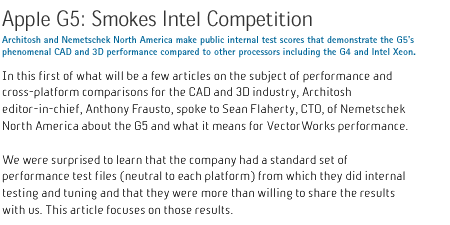
Back
in the fall of last year Architosh began talking to numerous
developers -- who have been in the Macintosh market for years
-- about what they thought of Apple's new Power Mac G5 with
its new 64-bit
IBM chip. We were interested to know just how they felt
about these new machines and what kind of performance advantage
they really gave Apple, if any at all. We even began talking
about a new Architosh Benchmark Suite
for Architecture -- co-developed with a set of developers
who support that market space. To our surprise everyone we
talked to said to "count them in" on the benchmark
suite because they were 100 percent behind the Mac and 100
percent excited about the new G5 processor inside the new
Power Mac.
One
of the things I would like to point out to those reading this
is that Nemetschek North
America is not alone in being excited about the new G5
and the Mac platform. A number of developers, some new some
old to the Mac space, are incredibly
excited about the OS X platform in general and the hardware
architecture Apple had created with the Power Mac G5.
Let's
take a look at the scores and get into the discussion about
them. Nemetschek has some internal testing files that test
VectorWorks performance across three critical areas: 1)
2D Redraw speed - an area that test
the general 2D CAD drawing performance, 2) Rendering
performance - testing the calculation
times to finish various renders, and 3) Solids modeling
- testing the length it takes for various
modeling operations to complete. At the very
end of this article we have a summary graph (click on all
graphics for a larger image you can read):
Interview:
Fall 2003
AFR.
These scores are wonderful Sean. And very honest as you can
see when comparing to the older G4 hardware. Are they created
out of a test suite like Maxon's CineBench render performance
test suite?
Sean: We
don't have a simple canned test. Instead we use a number of
files with scripts that write out timing results to text files.
They are very process dependent right now to get repeatable
results (making sure comparable screen settings are used,
no background apps, etc.) and thus are not particularly user
friendly. We have a single and dual G5 in house which we used
for the scores you have.
AFR.
So this isn't something VectorWorks users can do at home on
their own?
Sean: Correct.
AFR.
So let's look at the 2D scores. The 2D redraw speeds are so
fast on the G5 1.8Ghz compared to the G4 before and
the 2.8Ghz Intel Xeons. Why is the G5 so darn fast in this
department? What's going on to make this machine so quick?
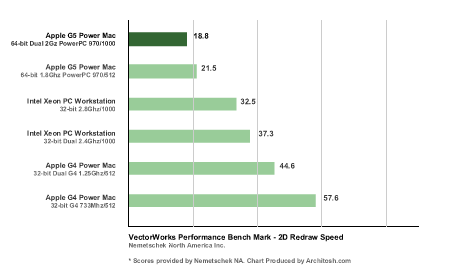 |
| 1.8Ghz
G5 Power Mac is 51 percent faster
than a 2.8Ghz Intel Xeon workstation at 2D Redraw VectorWorks
performance. |
Sean: This
surprised us also. Unfortunately, we haven't had a chance
to profile the results and figure out all the details.
AFR.
The numbers the single G5 1.8Ghz turns in with Solids Operations
are so much better than the previous G4 machines and even
the dual G4. Why is that? Is OpenGL faster under the G5 than
the G4?
Sean: Again
we haven't been able to dive in deep to the results yet. Solids
is an interesting test for me because the code is almost pure
C++;
there is very little platform-specific code involved. After
some consideration, we consider the two main areas likely
for this improvement consist of system architecture and floating
point.
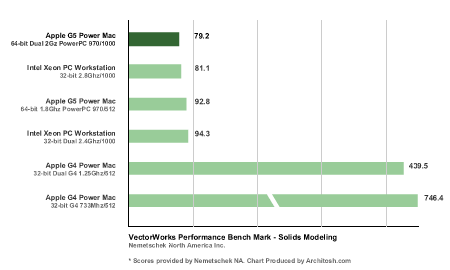
AFR.
So we are talking about the new
motherboard architecture on the G5...
Sean: Some
of the gain is no doubt due simply to the faster hardware
specs. The processor is 45 percent faster, the bus is twice
as wide -- which especially helps floating point -- and memory
access is significantly faster. Although not as memory intensive
as some other parts of VectorWorks, solids modeling does require
a lot of information to be moved around in the registers and
memory for calculation. So certain amount of the gain is due
to the raw gains in the throughput of the G5.
AFR.
Can you say more about floating point?
Sean: Floating
point has been a big area of tuning for us. Although the various
chip architectures seem to be close and constantly swapping
their [performance] leads in floating point speed, we saw
consistently slower performance starting on the Motorola G3
compared to Intel chips. When the well-known, publicized benchmarks
are run, they usually have compiler flags set to compile code
that puts floating point values into registers and on the
stack on a way that is optimal for that chip.
AFR.
So as many say, benchmark suites have compiler tuning advantages
that don't translate to real world performance.
Sean: In
the real world of legacy applications and cross-platform support
working applications often can't have their code optimized
as much. We found that when values were not optimally aligned,
floating point calculations on the G3 could take 80 times
longer than aligned ones. This compares to a three to four
times speed hit on Intel chips. We've done a lot of tuning
in this area, but it is a possibility that the G5 does not
suffer the same problem.
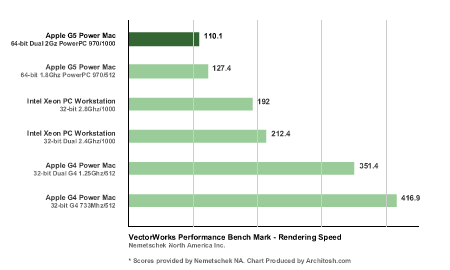 |
| 1.8Ghz
G5 Power Mac is 50 percent faster
than a 2.8Ghz Intel Xeon workstation at Rendering VectorWorks
performance. |
AFR.
Looking at the scores the single G5 turned in a combined total
score of 240 compared to the 2.8Ghz Intel Xeon processor's
score of 306.3 (lower is better); that's a 28 percent faster
difference. That's roughly equal or better than the type of
processor upgrade improvement that typically comes when a
company like Intel introduces a new processor architecture
or moves to a smaller manufacturing process. In other words,
it's 'upgrade time'. Does an IT manager not have an excellent
case for recommending these systems as the next VectorWorks
workstation? Wouldn't that kind of improvement warrant a substantial
improvement in CAD productivity?
Sean: Individual
users need to assess the performance increase based on how
they use it; just adding up our performance indices is not
an accurate measure of the performance gain to a customer.
We try to measure some of the more critical speed areas in
VectorWorks, but there are many we don't measure and only
the user can weigh them based on their value. It is also important
to note that if you take any session of use for an application
like VectorWorks, that nearly 90 percent of the total time
measured is spent waiting for user input.
That being said, I think the G5 to
G4 comparison shows a performance increase far beyond the
normal incremental chip upgrade and is a high value for the
money spent. I don't think we've seen a performance jump like
this since the PowerPC replaced the Motorola 68040 chip.
AFR.
Thanks for the info Sean.
Sean: You
are welcome.
So
The Overall Test Summary (combining the 2D Redraw test, the
Rendering test and the Solid Modeling test) is graphed below
(in seconds). As you can see both the dual 2.0Ghz G5 and the
single 1.8Ghz G5 were substantially faster than the workstation-grade
Intel Xeon machine at 2.8Ghz. (respectively 47 percent and
27 percent faster).
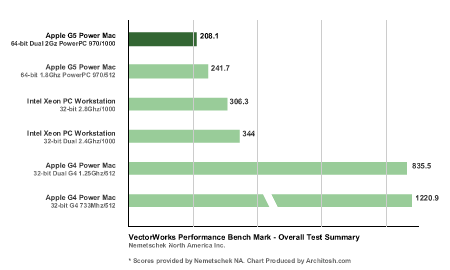
Quick
Facts:
Nemetschek North America
is a cross-platform CAD developer (VectorWorks) with approximately
equal share of Macintosh and Windows users worldwide. The
firm develops VectorWorks and the VectorWorks industry series
applications using Microsoft's developer tools for the Windows
version and Metrowerk's PowerPlant for the Macintosh version.
Both versions are built on top of the same exact code base
written in C++ with additional functionality built using the
application's VectorScript scripting language.
|






![]()
![]()